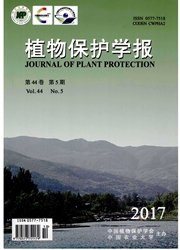

 中文摘要:
中文摘要:
亚洲玉米螟Ostrinia furrtacalis(Guenee)是转Bt基因玉米的靶标害虫,为探明其对Bt抗性的演化,在室内开展了Cry1Ac蛋白胁迫下的抗性汰选及Cry1Ac抗性品系对4种Bt蛋白的交互抗性研究。通过在人工饲料中添加CrylAc蛋白饲养亚洲玉米螟27代,获得了对Cry1Ac产生14.0倍抗性的品系ACB-AcR,同时对Cry1Ab蛋白亦产生了6.3倍的交互抗性,继续在恒压下连续汰选至82代,对Cry1Ac的相对抗性达到48.9倍,而对Cry1Ab的交互抗性倍数没有提高。进一步测定和比较4种Bt蛋白Cry1Ac、Cry1Ab、Cry1Ah和Cry1Ie对敏感品系ACB-BtS和抗性品系ACB-AcR的毒力,结果显示,ACB—AcR对Cry1Ah的相对抗性倍数达14.9倍,有显著的交互抗性;对Cry1Ab的相对抗性倍数为4.3倍,交互抗性水平较低;对Cry1Ie的相对抗性倍数为0.9,即无交互抗性。4种蛋白对抗、感品系的EC50表明,ACB-AcR品系对Cry1Ac蛋白产生了显著的抗性,相对抗性达到32.6倍,对Cry1Ah和Cry1Ab有低水平的交互抗性,而对Cry1Ie没有交互抗性。
 英文摘要:
英文摘要:
Asian corn borer, Ostrinia furnacalis (Guenee), is targeted by the transgenic Bt maize. The evolution of resistance to Cry1 Ac toxin by the Asian corn borer was investigated through the selection by exposure larvae to the toxin incorporated into artificial diet. Cross-resistance to other Bt toxins was determined by bioassay. A resistant strain of Asian corn borer, ACB-AcR, selected with Cry1Ac protein incorporated into artificial diet developed significant levels of resistance (14-fold) to Cry1 Ac protein and 6.3- fold cross-resistance to Cry1 Ab after 27 generations selection. Additionally, ACB-AcR maintained on a constant concentration (8 μg/g) was developed 48.9-fold resistance to Cry1 Ac after 82 generations selection, but the cross-resistance to Cry1Ab did not increased. LC50s of Cry1Ab, Cry1Ah, and Cry1Ie were measured to ACB-AcR and ACB-BtS stains. Significantly, the highest cross-resistance was observed to Cry1Ah with resistance ration up to 14.9-fold. Low levels (4.3-fold) of cross-resistance were detected with Cry1Ab. In contrast, Cry1Ie susceptibility was unaffected by selection with Cry1Ac. Based on EC50s, ACB-AcR developed 32.6-fold resistance to Cry1Ac protein. Relatively low levels of cross-resistance were observed to Cry1Ah and Cry1Ab. However, no cross-resistance was detected with Cry1le.
 同期刊论文项目
同期刊论文项目
 同项目期刊论文
同项目期刊论文
 期刊信息
期刊信息
